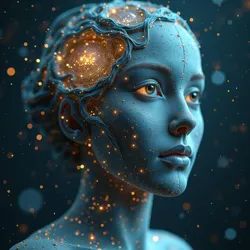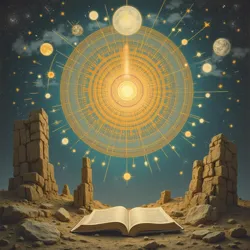Oneiromantic Linguistics

Discipline focused on interpreting linguistic elements found within dream states, exploring subconscious communication.
Paleo-Semiotics
interpretation of dream language
Somnial Lexigraphy, Hermeneutics of Nocturnal Discourse
Oneirolexicographers, Somnilinguists
Linguistic Dream Weaving
*Oneiromantic Linguistics, also referred to as Somnial Lexigraphy or the Hermeneutics of Nocturnal Discourse*, is a discipline within the broader field of Paleo-Semiotics that focuses on the interpretation and decipherment of linguistic elements encountered within dream states. It posits that dreams, particularly the verbal and textual components therein, are not merely random neurological firings or purely symbolic representations of waking life anxieties, but can also function as a unique form of communication, potentially offering insights into subconscious thought, forgotten languages, and even, according to some proponents, glimpses into non-ordinary realms of consciousness or latent linguistic structures within the human mind itself. Oneiromantic Linguistics is closely associated with practices like Linguistic Dream Weaving and is considered a vital, albeit controversial, tool in the pursuit of the Cipher of Lost Tongues.
Etymology and Terminology
The term "Oneiromantic Linguistics" is derived from the Greek words "oneiros" (ὄνειρος), meaning "dream," "manteia" (μαντεία), denoting "divination" or "interpretation," and "linguistics," the scientific study of language. The term thus literally translates to "dream-interpreting linguistics." Alternative terms such as "Somnial Lexigraphy" combine the Latin "somnium" (dream) with "lexigraphy" (the practice of writing dictionaries or describing languages), emphasizing the textual or linguistic aspects found within dreams. "Hermeneutics of Nocturnal Discourse" highlights the interpretative nature of the discipline, framing dream language as a form of "nocturnal discourse" requiring specific hermeneutic approaches.
 Exploring terms like Somnial Lexigraphy and Hermeneutics of Nocturnal Discourse in the study of dream language.
Exploring terms like Somnial Lexigraphy and Hermeneutics of Nocturnal Discourse in the study of dream language.Within the scholarly circles of the Order of Silent Scribes, practitioners of Oneiromantic Linguistics are sometimes referred to as Oneirolexicographers or Somnilinguists. These terms are not widely used outside of these specialized groups, but they serve to denote the specific expertise and focus of scholars dedicated to this field.
Principles and Methods
Oneiromantic Linguistics operates on several core principles that distinguish it from conventional linguistic study and dream analysis:
 Dream text transcription, linguistic analysis, and comparative lexicography are employed to study dream language.
Dream text transcription, linguistic analysis, and comparative lexicography are employed to study dream language.The Linguistic Nature of Dreams
The foundational principle is that dreams are not solely visual or emotional experiences, but often contain linguistic elements – spoken words, written texts, internal monologues, and linguistic structures. These elements are not seen as mere byproducts of dream imagery but as integral components of the dream narrative and potentially carriers of meaning in their own right. Unlike psychoanalytic approaches that might prioritize symbolic interpretation of dream imagery, Oneiromantic Linguistics focuses on the explicit linguistic content, treating dream utterances and texts as primary data.
Subconscious Lexicon and Grammar
Proponents of Oneiromantic Linguistics suggest that the subconscious mind possesses a vast and largely untapped linguistic reservoir. This reservoir may contain elements of learned languages that have faded from conscious memory, fragments of ancestral languages, or even, in more radical interpretations, innate linguistic archetypes or access to the universal grammar postulated by theories like the Cipher of Lost Tongues. Dreams, in this view, provide a window into this subconscious lexicon and grammar, allowing linguistic structures not readily accessible in waking consciousness to surface.
Dream Language as a Unique Dialect
Dream language is often considered a unique dialect or register distinct from waking language. It may exhibit peculiar grammatical structures, neologisms (newly coined words), and semantic shifts. Oneiromantic Linguistics aims to identify and categorize these unique features, seeking to understand the internal logic and rules that govern dream language. This involves analyzing phonetic patterns, morphological structures, syntactic arrangements, and semantic relationships within dream narratives.
Contextual Dream Interpretation
While focusing on linguistic elements, Oneiromantic Linguistics does not disregard the broader context of the dream. The emotional tone, recurring symbols, personal history of the dreamer, and even external factors like the dreamer's waking life concerns are considered crucial for a nuanced interpretation. The linguistic analysis is interwoven with contextual understanding to avoid simplistic or decontextualized readings of dream language. This holistic approach acknowledges that dream language is not an isolated phenomenon but is embedded within the complex tapestry of the dreamer's psyche and experiences.
Methodological Approaches
The methods employed in Oneiromantic Linguistics are diverse, drawing upon techniques from both linguistics and dream studies. These include:
-
Dream Text Collection and Transcription: Detailed records of dreams are meticulously collected, often through dream journaling or post-awakening recall. These dream narratives are then transcribed verbatim, paying close attention to linguistic details – specific words, phrases, grammatical structures, and even the perceived tone and rhythm of spoken dream language.
-
Linguistic Analysis: Standard linguistic analysis techniques are applied to dream texts. This includes phonological analysis (examining sound patterns), morphological analysis (breaking down words into their component parts), syntactic analysis (analyzing sentence structure), and semantic analysis (interpreting meaning). Special attention is paid to deviations from standard waking language norms.
-
Comparative Lexicography: Dream lexicons are compiled, noting recurring words, neologisms, and unusual semantic usages. These dream-specific lexicons are then compared across multiple dream reports from the same individual or across different individuals to identify patterns and potential shared linguistic features.
-
Gematric Dream Parsing: Drawing inspiration from Gematric Resonance Analysis, some practitioners explore numerical or symbolic values associated with dream words, seeking hidden layers of meaning or connections to other symbolic systems. This approach is more esoteric and less widely accepted within mainstream Oneiromantic Linguistics but is practiced by certain schools within the Order of Silent Scribes.
-
Cross-Linguistic Dream Comparison: Dreams are collected and analyzed from individuals speaking different waking languages. This comparative approach aims to identify universal or culture-specific features of dream language, potentially shedding light on the influence of waking language on dream language and vice versa. It also helps to distinguish between language-specific dream elements and potentially universal subconscious linguistic structures.
-
Lucid Dream Experimentation: In lucid dreams (dreams where the dreamer is aware they are dreaming), some Oneiromantic Linguists attempt to consciously manipulate or interact with dream language. This might involve asking dream characters about the meaning of dream words, attempting to learn dream grammar rules, or even trying to "speak" or "write" in dream languages. Such experiments are highly subjective but can provide unique first-person insights into the nature of dream language.
Historical Development
The roots of Oneiromantic Linguistics can be traced back to ancient cultures that placed significant emphasis on dreams as sources of divine communication or prophetic insight. Dream interpretation traditions in ancient Mesopotamia, Egypt, Greece, and various indigenous societies often involved analyzing spoken words or written symbols appearing in dreams. However, these early approaches were primarily divinatory or symbolic, rather than systematically linguistic.
 Tracing the origins of Oneiromantic Linguistics from ancient practices to modern esoteric scholarship.
Tracing the origins of Oneiromantic Linguistics from ancient practices to modern esoteric scholarship.A more direct precursor can be found in the late 19th and early 20th centuries with the emergence of depth psychology. Sigmund Freud's work on dream interpretation, while not explicitly linguistic in focus, highlighted the importance of dream narratives and the latent content expressed through dream symbolism. Carl Jung's concept of archetypes and the collective unconscious further suggested a deeper, potentially universal layer of subconscious symbolism that could manifest in dreams, including linguistic forms.
However, Oneiromantic Linguistics as a distinct field began to coalesce primarily within the esoteric and scholarly circles associated with the Monastery of Ephemeral Scrolls and the Order of Silent Scribes during the late Cycles of Whispers. Inspired by fragmented texts attributed to Herizhon the Unseen and the ongoing pursuit of the Cipher of Lost Tongues, these scholars sought to apply linguistic methodologies to the enigmatic realm of dreams. Early pioneers, such as the elusive figure known only as Master Ianthe of Somniloquy, developed initial frameworks for dream text analysis and comparative somnial lexicography. Ianthe's seminal, though largely apocryphal, work, Nocturnal Glossaries: A Primer of Dream Lexemes, is said to have laid the groundwork for many subsequent developments in the field, though no verified copies of this text have ever been definitively located outside of whispered rumors among the Order.
The discovery of the Somniloquy Scrolls of Eldoria within the Vault of Unspoken Truths further spurred interest in Oneiromantic Linguistics. These scrolls, containing transcriptions of sleep-state utterances, provided a substantial corpus of dream language data for analysis. Scholars of the Order meticulously studied these scrolls, developing increasingly sophisticated techniques for deciphering and interpreting the seemingly nonsensical pronouncements contained within them.
In recent Cycles, advancements in Informal Transmission technologies and Noetics have also influenced Oneiromantic Linguistics. Some researchers explore the possibility of using advanced noetic devices to record and analyze dream language directly, bypassing the limitations of post-awakening recall. Others investigate potential links between dream language and Informal Flux, hypothesizing that dream states may offer heightened sensitivity to these subtle informational currents.
Techniques and Applications
Oneiromantic Linguistics, while still a developing field, has found applications in several areas, both within and beyond the esoteric circles of the Order:
Decipherment of Cryptic Texts
The techniques of Oneiromantic Linguistics are sometimes applied to the decipherment of cryptic or fragmented texts from ancient cultures, particularly those that exhibit dream-like or symbolic qualities. The Veiled Script of the Sunken City of Ys, for instance, has been approached by some scholars using oneiromantic methodologies, seeking to identify dream-like linguistic structures or subconscious patterns that might unlock its meaning. The premise is that certain ancient writing systems may have been influenced by or deliberately designed to tap into subconscious modes of thought, making oneiromantic approaches potentially relevant for their decryption.
Subconscious Language Acquisition
Some proponents suggest that Oneiromantic Linguistics could be harnessed for accelerated language learning. By analyzing dream language patterns, it might be possible to identify optimal methods for engaging the subconscious mind in language acquisition processes. This is a highly speculative area, but initial experiments within the Monastery of Ephemeral Scrolls have explored techniques such as "somnial language immersion," where language learning materials are presented in modified forms designed to be processed during sleep and dream states, guided by principles derived from oneiromantic analysis of dream language.
Therapeutic Dreamwork
While distinct from traditional dream analysis in psychotherapy, Oneiromantic Linguistics offers a unique perspective on therapeutic dreamwork. By focusing on the explicit linguistic content of dreams, it may be possible to gain clearer insights into subconscious communication patterns, unresolved conflicts expressed through language, or even latent creative potentials manifested in dream utterances. Some practitioners integrate oneiromantic linguistic analysis with therapeutic techniques to facilitate deeper self-understanding and personal growth.
Paleo-Semiotic Research and Cipher Pursuit
The most central application of Oneiromantic Linguistics remains its contribution to Paleo-Semiotics and the quest for the Cipher of Lost Tongues. Dream language is seen as a potential microcosm of the universal linguistic structures sought by Paleo-Semioticians. By studying the grammar, lexicon, and semantic properties of dream language, researchers hope to identify fundamental linguistic principles that might transcend specific waking languages and offer clues to the underlying architecture of all possible communicative systems. The anomalies and unique features of dream language are viewed as potentially reflecting deeper linguistic realities, perhaps even echoing the primordial linguistic template that Herizhon the Unseen described.
Artistic and Creative Inspiration
Beyond purely academic or esoteric applications, Oneiromantic Linguistics has also influenced artistic and creative endeavors. Artists, writers, and musicians have drawn inspiration from the unique linguistic landscapes of dreams, incorporating dream-like language patterns, neologisms, and surreal semantic juxtapositions into their works. The exploration of dream language can serve as a source of creative innovation, pushing the boundaries of conventional linguistic expression and exploring the poetic and evocative potential of subconscious linguistic forms. The Dream-Weavers' Guild of Somnambula, a secretive artistic collective, is known for its works heavily influenced by oneiromantic principles, creating art that aims to evoke the logic and linguistic textures of the dream world.
Relation to Paleo-Semiotics and Cipher of Lost Tongues
Oneiromantic Linguistics is inextricably linked to Paleo-Semiotics and the pursuit of the Cipher of Lost Tongues. It is often considered a specialized sub-discipline within Paleo-Semiotics, focusing specifically on dream language as a potential key to unlocking the broader mysteries of lost and primordial linguistic structures.
Paleo-Semiotics, in its quest to understand the fundamental principles governing all possible languages, seeks evidence from diverse sources, including the study of extinct languages, Glossal Synchronicity, and Aphasic Glossolalia. Dream language, with its often bizarre and seemingly illogical yet structured nature, is seen as another crucial data point in this larger investigation.
The Cipher of Lost Tongues, as a conceptual framework for deciphering the "silences" between languages, is believed by some to be potentially accessible through the study of dream language. Dreams, being a product of the subconscious mind, are theorized to be less constrained by the conventions and limitations of waking language, perhaps offering a more direct glimpse into the underlying linguistic archetypes or universal grammar that the Cipher represents.
Practitioners of Oneiromantic Linguistics often collaborate with Paleo-Semioticians, sharing dream language data and linguistic analyses in the hope of identifying patterns or recurring structures that might contribute to the decipherment of the Cipher. The Order of Silent Scribes, a central institution in both fields, actively promotes this interdisciplinary collaboration, viewing Oneiromantic Linguistics as an essential tool in the ongoing quest for linguistic understanding.
Criticisms and Challenges
Oneiromantic Linguistics faces numerous criticisms and challenges, both methodological and epistemological:
Subjectivity and Verifiability
A primary criticism is the inherent subjectivity of dream reports. Dream recall is notoriously unreliable, and dream narratives are often fragmented, distorted, or influenced by waking life biases. The linguistic data collected is thus filtered through the subjective experience and memory of the dreamer, raising concerns about the objectivity and verifiability of findings. Critics argue that interpretations of dream language are prone to subjective biases and lack empirical rigor.
Lack of Standardized Methodology
Oneiromantic Linguistics is still a nascent field, lacking standardized methodologies and agreed-upon analytical frameworks. Different practitioners may employ diverse techniques and interpret dream language data in varying ways, leading to inconsistencies and difficulties in replicating or validating research findings. The absence of a unified methodological approach hinders the field's progress and makes it vulnerable to accusations of being pseudoscientific.
Neurological Reductionism
Mainstream neuroscience often explains dream language as a byproduct of random neuronal activity during sleep, lacking inherent meaning or structured linguistic properties. From this perspective, attempting to decipher dream language as a meaningful form of communication is seen as a misguided endeavor, attributing significance to what is essentially neurological noise. Critics argue that Oneiromantic Linguistics overinterprets random brain activity and neglects more parsimonious neurological explanations for dream phenomena.
Difficulty in Falsification
Many of the claims made within Oneiromantic Linguistics, particularly those relating to subconscious lexicons, universal grammar, or access to non-ordinary realms, are difficult, if not impossible, to falsify using conventional scientific methods. This lack of falsifiability raises concerns about the scientific status of the field and its susceptibility to confirmation bias, where interpretations are selectively chosen to support pre-existing beliefs or hypotheses.
Cultural and Linguistic Relativism
The influence of waking language and culture on dream content is undeniable. Critics argue that dream language is not a universal or independent linguistic system, but is heavily shaped by the dreamer's linguistic and cultural background. Therefore, attempts to identify universal linguistic structures in dreams may be confounded by cultural and linguistic biases, making it difficult to disentangle truly universal features from culturally specific ones.
Despite these criticisms, proponents of Oneiromantic Linguistics maintain that the unique linguistic phenomena observed in dreams warrant further investigation. They argue that dismissing dream language as mere noise or subjective fantasy prematurely closes off a potentially valuable avenue for exploring the deeper mysteries of language, consciousness, and the human mind's linguistic capacities. Ongoing research and methodological refinements within the field continue to address some of these criticisms, striving to establish a more rigorous and empirically grounded approach to the hermeneutics of nocturnal discourse.